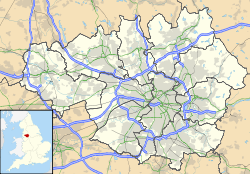- People's History Museum
-
Coordinates: 53°28′53″N 2°15′12″W / 53.481389°N 2.253333°W
People's History Museum 
Artist's impression of the new People's History MuseumLocation Manchester, United Kingdom Type History museum Website http://www.phm.org.uk/ The People's History Museum (formerly the National Museum of Labour History until 2001) in Manchester, England is the United Kingdom's national centre for the collection, conservation, interpretation and study of material relating to the history of working people in the UK. It is located in a Grade II listed, former hydraulic pumping station on the corner of the Bridge Street and Water Street designed by City architect Henry Price.[1][2][3]
The museum tells the story of the history of democracy in Britain and about ordinary people’s lives at home, work and leisure over the last 200 years. It contains a collection of printed material, physical objects and photographs which celebrate the lives of ordinary people at work, rest and play. Some of the topics covered include: Popular Radicalism, the Peterloo Massacre, 19th Century Trade Unionism, the Women's Suffrage movement, Dockers, the Co-op Retail movement, the 1945 General Election and football.
It also houses an important archive of material relating to the history of working people in Britain. Its collections include papers and documents created by the Labour Party, the former Communist Party of Great Britain, the co-operative movement and the Department for Work and Pensions.
Contents
History
The Trade Union, Labour and Co-operative History Society operated a collection at Limehouse Town Hall between 1975 and 1986, with the bulk of the collections in storage.[citation needed] The museum moved to Manchester and re-opened in 1990 at the Grade II* listed former Mechanics' Institute at 103 Princess Street.[3][4]
In 1994, the museum opened the Pump House People's History Museum containing a public gallery at the present site on Bridge Street. The two sites were both rebranded as the "People's History Museum" in 2001.[3] The Bridge Street site closed for a £12.5m redevelopment in October 2007.[5] The redevelopment included the refurbishment of the existing Pump House and the construction of a four storey extension alongside it. A glass walk way was constructed to link the two buildings.[6] The museum reopened on 13 February 2010.[7][8]
Contents
The new building houses the museum galleries, changing exhibitions, education service, Labour History Archive and Study Centre (formerly at 103 Princess Street), Textile Conservation Studio, corporate facilities, café and shop. The new People’s History Museum has more coherent museum galleries designed to display the collection with improved interactive exhibits and interpretation.[citation needed]
A larger changing exhibition gallery allows more of the museum’s own collections to be seen, as well as topical national touring exhibitions. A dedicated community gallery provides local people with a space to display their own work while the integration of the Labour History Archive and Textile Conservation Studio allows visitors to see the museum’s work.[citation needed]
References
- ^ Former Hydraulic Power Station In Grounds Of City College, Heritage Gateway, http://www.heritagegateway.org.uk/Gateway/Results_Single.aspx?uid=457830&resourceID=5, retrieved 28 February 2010
- ^ Field, Corinne (16 August 2004), Pump Up The Volume - Manchester Hydraulic Heritage, Culture 24, http://www.culture24.org.uk/places+to+go/north+west/manchester/art23500, retrieved 28 February 2010
- ^ a b c Little, Steve (PDF), Conservation Plan The Pump House - People's History Museum, Bridge Street, Manchester, Manchester City Council, http://www.publicaccess.manchester.gov.uk/associateddocs/Default1.aspx?083105-SSI-0006.pdf, retrieved 28 February 2010
- ^ 103 Princess Street, Heritage Gateway, http://www.heritagegateway.org.uk/Gateway/Results_Single.aspx?uid=456840&resourceID=5, retrieved 28 February 2010
- ^ Haile, Deborah (19 January 2008), People's museum wins cash boost, Manchester Evening News, http://www.manchestereveningnews.co.uk/news/s/1032799_peoples_museum_wins_cash_boost, retrieved 28 February 2010
- ^ Bosley, Kirsty (31 July 2008), Glass walkway to restoration, Manchester Evening News, http://www.manchestereveningnews.co.uk/news/s/1060781_glass_walkway_to_restoration, retrieved 28 February 2010
- ^ People's History Museum set to re-open, Manchester Evening News, 19 February 2010, http://www.manchestereveningnews.co.uk/news/s/1192242_peoples_history_museum_set_to_reopen, retrieved 28 February 2010
- ^ History, People's History Museum, http://www.phm.org.uk/about-us/history/, retrieved 28 February 2010
Further reading
- Gibbs, Caroline (1980), "The National Museum of Labour History", History Workshop Journal (Oxford University Press) 10 (1): 191–193, http://hwj.oxfordjournals.org/content/10/1/191.extract
- Bird, Stephen (1994), "A Specialist Labour History Archive The National Museum of Labour History Archive Centre", History Workshop Journal (Oxford University Press) 37 (1): 170–176, http://hwj.oxfordjournals.org/content/37/1/170.extract
External links
Museums and Galleries in Greater Manchester Art Historic house Local history and culture Military and war Natural history Science, engineering,
transportationSpecialized Hat Works · Manchester Jewish Museum · National Football Museum, Urbis (from 2012) · Manchester United Museum · Mossley Industrial Heritage Centre · Pankhurst Centre · People's History MuseumSee also List of museums in Greater ManchesterCategories:- Archives in Greater Manchester
- Museums in Manchester
- History museums in Greater Manchester
- Labour relations in the United Kingdom
Wikimedia Foundation. 2010.

